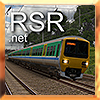- [WJ-R]: 1980s object removal (Castlethorpe/Hanslope area)
- [XCS]: Pending
- [UkTrainSys]: v0.3.2.0 released
- [Object Library]: Preparing...
- [Website]: Fifth version of website launched
 My openBVE videos and other comments from users and
myself can also be found via my YouTube
channel.
My openBVE videos and other comments from users and
myself can also be found via my YouTube
channel.Blog and Progress Updates
19th April 2009
Platform Generator utility released
Posted by Anthony Bowden on 19th April 2009 at 7:45 amAlan Wheeler’s new Platform Generator (Plat Gen) tool was released recently; head over to » eezypeazy.co.uk « to download this handy utility. The program creates a variety of photo-realistic customised platform segments, allowing route developers to choose the surface and side textures, create platform ramps, curved platform lengths at various radii, and more. The generated objects are placed via the .Freeobj command rather than the .Form commands. Here’s a screenshot of one of the resulting platforms at University station on the Cross-City South v1.4 route:
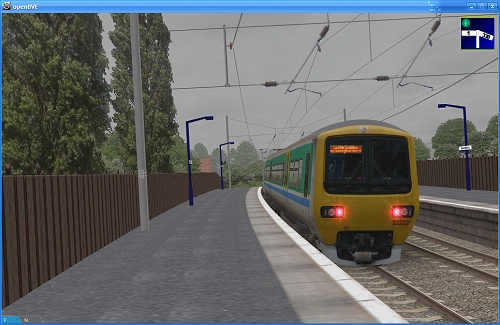 openBVE / Cross-City South v1.4 plus 323 screenshot |
Tags: Cross-City South, openBVE, openBVE Community, Screenshots, Software
Posted in openBVE | 2 Comments »
24th March 2009
openBVE v1.0 is here!
Posted by Anthony Bowden on 24th March 2009 at 12:26 am![]() After 347 days of development, openBVE version 1.0 has now been released! Personally I think this is an incredible achievement–not only that openBVE has been created in the first place, but that it’s been created in such a short space of time, considering the complexity and difficulties inherent in undertaking such a project, some of which I’ve become familiar with while following the development of the program and helping to understand some aspects of BVE Trainsim’s behaviour. Congratulations michelle.
After 347 days of development, openBVE version 1.0 has now been released! Personally I think this is an incredible achievement–not only that openBVE has been created in the first place, but that it’s been created in such a short space of time, considering the complexity and difficulties inherent in undertaking such a project, some of which I’ve become familiar with while following the development of the program and helping to understand some aspects of BVE Trainsim’s behaviour. Congratulations michelle. ![]()
Head over to the » official openBVE homepage « to download the latest in the stable branch of openBVE releases. Whether you’re a developer or a user, if you only use BVE Trainsim at the moment, now would be a good time to enter the world of openBVE.
michelle has also added some additional documentation to help you find your way around the program, which you can read here: » Using openBVE «. For BVE Trainsim, I found myself having to create help pages to guide newcomers through the installation and use of BVE, so hopefully I won’t need to go to such lengths any more, as these are very comprehensive, step-by-step instructions. However, if any of you still have problems installing openBVE, or using the Cross-City South with the program, let me know and I’ll see if I can assist. Depending on feedback over the coming weeks, I’ll see if I still need to work on the “openBVE Help” section of this site with regard to add-on installation, although I’ll certainly update my Driver’s Guide and Class 323 Tutorial soon.
Tags: openBVE, Screenshots
Posted in openBVE | No Comments »
openBVE v1.0: Are we nearing the end of the journey, or has it only just begun?
Posted by Anthony Bowden on 24th March 2009 at 12:24 am![]() Well, that’s partly up to us. michelle has published an in depth article in which she sets out her vision for how openBVE could evolve in future, along with various ideas and plans which could pave the way to v2.0, which you can read here: » The potential future of openBVE «. But without our input, discussion about future direction, or sufficient interest expressed in these ideas, some of these developments may never happen… It’s possible to see what an incredibly flexible solution could be created in future, allowing for far more than is currently possible if an extensible, modular design and plugin based architecture is developed; e.g. detailed simulation of any safety system without having to rely on built-in approximations, plugins which can load different file formats, or customisable physics plugins allowing better support for more diverse applications such as maglev or even bus simulation, and much more, while still supporting legacy BVE add-ons.
Well, that’s partly up to us. michelle has published an in depth article in which she sets out her vision for how openBVE could evolve in future, along with various ideas and plans which could pave the way to v2.0, which you can read here: » The potential future of openBVE «. But without our input, discussion about future direction, or sufficient interest expressed in these ideas, some of these developments may never happen… It’s possible to see what an incredibly flexible solution could be created in future, allowing for far more than is currently possible if an extensible, modular design and plugin based architecture is developed; e.g. detailed simulation of any safety system without having to rely on built-in approximations, plugins which can load different file formats, or customisable physics plugins allowing better support for more diverse applications such as maglev or even bus simulation, and much more, while still supporting legacy BVE add-ons.
To summarise, openBVE version 2 could (and remember this is all speculative at the moment) bring some much sought after functionality, such as true support for passing trains, parallel traffic and so-on, enabled by having more than one functional track (although this wouldn’t be a network of tracks which can be switched to and from at runtime, at this stage–this is something for the distant dream of version 3). Driving back and forth along a track could be better than in v1.0 as signalling could be functional in the reverse direction as well. 3D cabs with interactive controls, perhaps manipulated via the mouse, could be implemented. Weather plays an enormously important role on the real railway, and version 2 could bring us rain, snow and thunder, without having to “cheat” with pre-defined sound samples or creating scenery objects to create such effects, as I’ve done thus far. Wind simulation could result in altered performance characteristics of trains as well, making driving more challenging. Better Sun and Moon simulation could be provided as well, with realtime day/night transitions occuring, showing off openBVE’s illuminated object capabilities, especially at twilight. Then there are improvements to how add-ons are obtained and managed; currently this is messy where BVE is concerned and intimidating to the beginner, and all this could change with version 2, where a directory of add-ons and download locations could be referenced from within openBVE, with add-ons perhaps installed automatically via the user interface. A Level of Detail (LOD) system could be implemented, which might be enormously helpful on more geometrically complex routes, like Watford Junction to Rugby, or with more detailed exterior car objects perhaps.
Sounds fantastic doesn’t it? However, no feature is guaranteed to be implemented; indeed openBVE version 2 itself is not guaranteed to be developed–it depends on our level of interest, and our willingness to help.
This vision of the future is only likely to materialise with our support, so if we want any of this to happen, we–developers or users–need to make sure that we make known our interest in openBVE’s future direction and talk about it, express our intent to use these new features if we want them, and then experiment with new functionality as it emerges; in other words, take part in the project. This way, michelle knows what the community actually wants, she doesn’t waste her time implementing functionality which isn’t going to be used, and problems and pitfalls can be discussed or resolved before too much work is done. If you have any thoughts about this path to version 2, then you can post your thoughts in » this forum thread «; don’t post a wishlist though, consider the options already outlined in the article, and decide which are important and worth pursuing, and then, these can be prioritised and discussed. I’ll add my own thoughts later as well. Drop any comments on this blog too if you like, as I’m also interested in what you think is important or worthwhile.
Lets not miss out on a potentially wonderful opportunity here–we have someone in our midst who not only has a vision which could benefit us all, but also the ability and willingness to implement that vision, and it would be highly regrettable if our community lost this opportunity while it’s available to us. My concern is that if we don’t look to the future now, we may end up settling for what we’ve got in openBVE v1.0 (or even BVE 5 when it’s released), and then in a few years we’ll wish we had something better, only to find that it’s too late and michelle has moved on to other fields where I’ve no doubt her talents would be appreciated, or we may find that mackoy no longer works on BVE Trainsim either, in which case we’ll wish we could have done more to keep michelle motivated. Alternatively, we can actively create and shape the future of our hobby together, and demonstrate that it’s worth michelle’s while in continuing the project onwards towards version 2, or even beyond.
Of course I know that there aren’t many of us developers around, but surely between the relatively few of us (along with an increasingly enthusiastic user base), we can contribute enough to enable openBVE development to continue and evolve into a free trainsim we could only have dreamt of a few years ago, and as the program gains functionality, hopefully pick up new developers and programmers along the way?
Tags: openBVE
Posted in openBVE | 8 Comments »
Cross-City South v1.4 Progress
Posted by Anthony Bowden on 24th March 2009 at 12:22 amI am sorry for the lack of updates during the past few weeks. This is partly because more of my time has been taken up by non-railsim related stuff during the past month, but also because I’ve completed most of the experimentation as far as XCS v1.4’s animated objects are concerned now (I have to stop somewhere otherwise I’ll never finish it), and what remains to be done isn’t especially newsworthy in comparison–mainly adding what I’ve already shown throughout the route. I also can’t imagine that any of you would be particularly interested in reading about that sub-folder I renamed two days ago, those trees I added to a set of ground objects, or that exciting search through my archives to find a photo of a class 323’s seating?! ![]() However, the project is going well, and I should have some more news soon.
However, the project is going well, and I should have some more news soon.
Tags: Cross-City South, openBVE
Posted in openBVE | 4 Comments »
27th February 2009
Updated Functions
Posted by Anthony Bowden on 27th February 2009 at 10:00 pmThanks to a certain mathematically adept someone, I’ve now updated some of the code examples in my last blog entry, namely the function used for wheelset rotation which is now better in terms of performance and ease of use, and also the code which “plugs” the doors into the bodyside when they’re closed, making the visual effect better as the doors don’t “jump” into position any more. The updated functions are now highlighted in yellow in my 26th February entry…
Tags: Animated Objects, Functions, openBVE
Posted in openBVE | No Comments »
26th February 2009
Animated Exterior Car Objects
Posted by Anthony Bowden on 26th February 2009 at 10:00 pm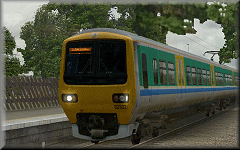 As most of you will likely know already, » openBVE « now enables developers to use animated exterior car objects. I was pleasantly surprised by all the positive feedback and comments regarding my last video which I uploaded to YouTube (thank you!), but one criticism which was pointed out several times was the disparity between the quality of the scenic visuals, and the rather simplistic objects used to represent the class 323 EMU–the objects were fine for BVE’s passing trains, but less so when you can move the camera up close and look at the details, or lack thereof. I didn’t think it was worth spending much time on this latter aspect until animation could be applied to the exterior car objects, but now this is possible, I’ve been working on some far better 3D models for the class 323. I had hoped to get this task finished sooner, but it’s taken longer than I originally expected unfortunately–the main difficulty was getting the rounded cab looking right, and texturing it correctly. However, I’m now happy with the appearance, and so I present the work-in-progress fully 3D exterior car objects for openBVE and Cross-City South v1.4. Incidentally, as with all my openBVE/BVE objects, these models are entirely hand coded, with no “help” from 3D modelling software.
As most of you will likely know already, » openBVE « now enables developers to use animated exterior car objects. I was pleasantly surprised by all the positive feedback and comments regarding my last video which I uploaded to YouTube (thank you!), but one criticism which was pointed out several times was the disparity between the quality of the scenic visuals, and the rather simplistic objects used to represent the class 323 EMU–the objects were fine for BVE’s passing trains, but less so when you can move the camera up close and look at the details, or lack thereof. I didn’t think it was worth spending much time on this latter aspect until animation could be applied to the exterior car objects, but now this is possible, I’ve been working on some far better 3D models for the class 323. I had hoped to get this task finished sooner, but it’s taken longer than I originally expected unfortunately–the main difficulty was getting the rounded cab looking right, and texturing it correctly. However, I’m now happy with the appearance, and so I present the work-in-progress fully 3D exterior car objects for openBVE and Cross-City South v1.4. Incidentally, as with all my openBVE/BVE objects, these models are entirely hand coded, with no “help” from 3D modelling software.
Currently the objects are rather more complex than I originally intended (so far, the entire three coach EMU contains around 8200 vertices/4900 faces), and there is a performance penalty that comes with using them; on a fairly typical BVE route, framerates should be okay, but when paired with a very highly detailed and intensively animated route such as Cross-City South v1.4, a fast PC will likely be required to enjoy both extensively detailed animated scenery and detailed external car objects with reasonable framerates. What I intend to do, for those of you with slower hardware, is release alternative versions of the exterior car objects with lower polygon counts, and because of the way I’ve created the textures, the end result should still look good despite less complex geometry. Even these lower detail versions will be rather better than the previous objects though. ![]() So ultimately, if framerates are a problem, you can simply choose either richly detailed scenery, or richly detailed train objects, depending on which is more important to you.
So ultimately, if framerates are a problem, you can simply choose either richly detailed scenery, or richly detailed train objects, depending on which is more important to you.
Currently, the models include the following standard animated features:
- Rotating wheelsets including wheelslip effects (with provision for animated suspension, and bogie rotation should such functionality be possible in future)
- Bi-parting, sliding plug doors (some issues with door open/close sound synchronisation–see below)
- Moving window reflections (twin-layered with transparency, to create a parallax effect)
The models also include the following animated features linked to plugin (UKMUt.dll) variables:
- Windscreen wipers (left/right sweep, plus arc motion; the wipers aren’t perfect–see below)
- Head and tail lights (both ends of train)
- Interior lights (on or off via pantograph up/down button)
- LED destination display with flicker (on or off via pantograph up/down button)
- Working pantograph (all illuminated features also extinguish when pantograph is lowered)
I’ve also prepared another video to show these features. Please note, the 3D objects aren’t finished yet; some textures need updating, and I’ve yet to add interior fittings. Developers might want to continue reading on, as I’ll explain how some of these animations have been implemented, and share some sample code from the .ANIMATED objects.
Video: Demonstration of class 323 animated exterior car objects (work-in-progress) » Link to YouTube page (HD – best quality) «
|
I also thought you might like to see a high resolution image of Cross-City South v1.4 and the new high detail class 323; in this screenshot, I’m running openBVE fullscreen at a resolution of 1280×1024, with 8x anti-aliasing and 16x anisotropic filtering enabled (on a Radeon HD 2600 Pro graphics card). Bilinear interpolation was enabled in openBVE’s settings, with the Transparency mode set to Sharp. I was getting around 16-19 fps at the time; the framerates in the next version of openBVE will hopefully be a little higher due to performance optimisations where animated object normals are concerned, although this gain may be offset by the addition of more animated scenery objects to the route:
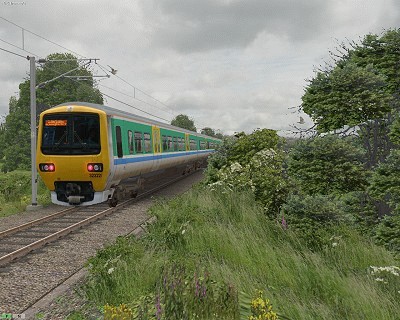 openBVE / Cross-City South v1.4 plus 323 screenshot–click to enlarge |
![]()
Rotating Wheelsets 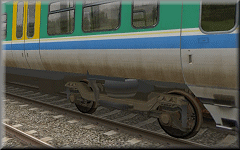 |
The first things I tried to animate were the wheelsets. Initially I had difficulty getting this to work as anticipated, and observed unexpected results while using the Speedometer variable, i.e. the resulting wheelset rotation appeared as though it were based upon acceleration rate rather than an actual velocity value (and » Ron « found the same when he first tried to animate wheelsets, it would seem). I usually like to try and figure out solutions to such problems myself, but sadly I’m not the reincarnation of Pierre de Fermat, and as such, my mathematical knowledge was insufficient. Fortunately, a way forward could be found over at the » openBVE Japanese « site, which includes some helpful material covering animated objects and functions. The following function can be used to rotate each wheelset:
Incidentally, 2.765 is the circumference of the wheel. The above formula works perfectly, but initially I wondered if it was more complicated than it needed to be, so I attempted to find a more simple alternative, and somehow arrived at the following formula, where the value 0.05949986086344 results from (pi / 0.88) / 60, where 0.88 is the diameter of the wheel:
Initially this seemed to work well, but on closer examination, the end result wasn’t as good as the more complex formula because the rate of rotation varies with the framerate, and I observed no difference in performance between the two anyway.
![]() Update
Update
Thanks to a certain mathematically adept someone, I now have a new formula which is better in terms of performance and ease of use:
|
|
Animated Doors 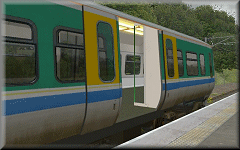 |
The bi-parting sliding plug doors are comprised of a pair of 3D door objects, which slide forwards and backwards via a translation along the Z axis, with values supplied via the left/rightdoors[i] variables, e.g:
[Object]
Position = 0.002, 0, -5.552
States = Class323_Door_2_R_Dark.csv, Class323_Door_2_R.csv
TranslateZFunction = rightdoors[0] + 0.864
TranslateXFunction = min[power[10 * (rightdoors[0] – 0.1), 3] + 1, 1] * 0.05
StateFunction = pluginstate[31]
[Object]
Position = 0.002, 0, -6.417
States = Class323_Door_2a_R_Dark.csv, Class323_Door_2a_R.csv
TranslateZFunction = -rightdoors[0] + 0.864
TranslateXFunction = min[power[10 * (rightdoors[0] – 0.1), 3] + 1, 1] * 0.05
StateFunction = pluginstate[31]
Left door animation:
[Object]
Position = -0.002, 0, -5.552
States = Class323_Door_2_L_Dark.csv, Class323_Door_2_L.csv
TranslateZFunction = leftdoors[0] + 0.864
TranslateXFunction = -min[power[10 * (leftdoors[0] – 0.1), 3] + 1, 1] * 0.05
StateFunction = pluginstate[31]
[Object]
Position = -0.002, 0, -6.417
States = Class323_Door_2a_L_Dark.csv, Class323_Door_2a_L.csv
TranslateZFunction = -leftdoors[0] + 0.864
TranslateXFunction = -min[power[10 * (leftdoors[0] – 0.1), 3] + 1, 1] * 0.05
StateFunction = pluginstate[31]
The StateFunction command is there to switch between illuminated and non-illuminated versions of the door objects, and pluginstate[31] is equivalent to the ats31 subject in the class 323’s panel2.cfg file (when used with Simon Gathercole’s UKMUt.dll), i.e. the Line Light indicator (so the lights appear to go out when the pantograph is lowered). The objects are also translated along the X axis so they “plug” into the bodyside when fully closed. Unfortunately the door open and close sounds aren’t fully synchronised with the door motion; with UK trains, warning beeps are heard before the doors actually start to close, but the beeps are contained within the door closing audio file, and of course the visible doors start to close as soon as the beeping starts. The duration of the door opening motion is also shorter than the duration of the door opening audio files. I haven’t tried having door animation controlled via plugin variables yet; when I have time I’ll look into this further.
Animated Window Reflections 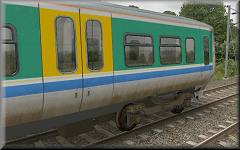 |
The window reflections are made from two semi-transparent surfaces, which have texture shifting functions applied, based upon the current speed of the train, e.g:
[Object]
Position = 0, 0, 0
States = ..\Class323_DMSO_1_WindowReflections.csv
TextureShiftXFunction = value + speed * 0.001
[Object]
Position = 0, 0, 0
States = ..\Class323_DMSO_1_WindowReflections_bg.csv
TextureShiftXFunction = value + speed * 0.0001
There’s a foreground reflection texture with transparency, showing near-track bushes, and there’s also a background reflection texture, showing a low resolution version of the backdrop (ground and sky) texture, and this surface’s texture is shifted more slowly than the foreground texture, creating a rather nice parallax effect when the train is in motion. The overall effect looks rather good in my opinion, but of course, if the reflection textures depict a Summer scene, but the train is used on a Winter route with snow, it looks a little silly…
Interior Illumination 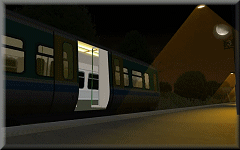 |
Interior lighting strips, along with interior fittings and additional semi-transparent yellow surfaces to lighten the windows when viewed from outside at night (allowing adequate night-lighting effects while still being able to have daytime window reflections), are displayed when the pantograph is raised, and swapped for non-emissive versions when the pan is lowered, so it’s possible to turn the carriage lights on and off. When the pantograph is lowered, all exterior lights are also state-changed or translated so they appear to extinguish, and won’t illuminate until the pantograph is raised again. This is achieved using if[pluginstate[31] ... ] commands, as demonstrated in the next section.
Animated Pantograph 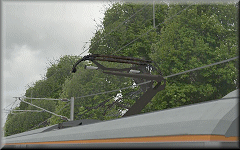 |
The pantograph itself can be visibly raised and lowered, with the head having a Y axis translation applied, and the upper and lower arms having X axis rotation, along with Y and Z axis translation applied. The pantograph animation is conditional upon the state of the value of plugin variable 31, or the ats31 subject in the class 323’s panel2.cfg. The code I’ve written which enables this is as follows (since updated on the 5th July 2009, thanks to a post by michelle herself):
[Object]
Position = 0, 4.24, 9.071
States = ..\Pantograph_BWHS_Head.csv
TranslateYFunction = if[pluginstate[31] == 0, if[value > -0.97, value – delta * 0.49, -0.97], if[value < 0, value + delta * 0.49, 0]]
[Object]
Position = 0, 4.24, 9.071
States = ..\Pantograph_BWHS_UpperArm.csv
TranslateYFunction = if[pluginstate[31] == 0, if[value > -0.45, value – delta * 0.225, -0.45], if[value < 0, value + delta * 0.225, 0]]
RotateXFunction = if[pluginstate[31] == 0, if[value > -0.29, value – delta * 0.145, -0.29], if[value < 0, value + delta * 0.145, 0]]
TranslateZFunction = if[pluginstate[31] == 0, if[value < 0.06, value + delta * 0.03, 0.06], if[value > 0, value – delta * 0.03, 0]]
[Object]
Position = 0, 4.24, 9.071
States = ..\Pantograph_BWHS_LowerArm.csv
TranslateYFunction = if[pluginstate[31] == 0, if[value > -0.45, value – delta * 0.225, -0.45], if[value < 0, value + delta * 0.225, 0]]
RotateXFunction = if[pluginstate[31] == 0, if[value < 0.27, value + delta * 0.135, 0.27], if[value > 0, value – delta * 0.135, 0]]
TranslateZFunction = if[pluginstate[31] == 0, if[value < 0.06, value + delta * 0.03, 0.06], if[value > 0, value – delta * 0.03, 0]]
Animated Wipers and Working Headlights 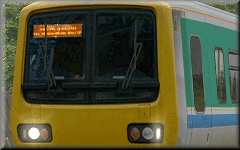 |
The windscreen wipers aren’t as good as I’d like them to be yet; when the if[pluginstate[i] ... ] conditions are satisfied and the truevalue formulae are executed, the wipers can jump to a position mid-sweep rather than starting to move from their currently held position. The same problem can happen when switching the wipers off as well, although the way I’ve implemented it, the wipers will stop in whatever position they are in when the wipers are turned off. More work needed here… Each wiper is comprised of two arms, and a wiper blade. The code so far, is as follows:
[Object]
States = ..\Class323_DMSO_Wiper_L_1.csv
Position = -0.56, 2.27, 0
RotateZFunction = if[pluginstate[198] > 0, power[1 – abs[cos[time]], 0.5] * 1.3, value]
[Object]
States = ..\Class323_DMSO_Wiper_L_1a.csv
Position = -0.5, 2.27, 0
RotateZFunction = if[pluginstate[198] > 0, power[1 – abs[cos[time]], 0.5] * 1.3, value]
[Object]
States = ..\Class323_DMSO_Wiper_L_1b.csv
Position = -0.55, 2.28, 0
TranslateXFunction = if[pluginstate[198] > 0, -power[1 – abs[cos[time]], 0.5] * 0.73, value]
TranslateYFunction = if[pluginstate[198] > 0, power[sin[time * 2], 2] * 0.13, value]
The last TranslateYFunction command moves the wiper blade up and down at the correct speed, which when combined with the X axis translation, creates the overall effect of an arc movement rather than a simple left-right motion.
The head (and tail) lights are linked to the proving lights in the cab (the ats20 and ats21 subjects in the class 323’s panel2.cfg). Each headlight configuration has it’s own csv object. The headlights will only be illuminated when the pantograph is also raised (dependent on the state of plugin variable 31, or the ats31 subject in panel2.cfg). When the tail lights at one end of the train are on, they automatically turn off at the other end of the train. For the rear of the train, the headlights can only illuminate if the tail lights are also off. The code which enables all of this is as follows (please note, I’m presenting two alternative ways of implementing the lights on the leading vehicle, the reason why can be found below):
Class323_DMSO_1.animated (lead vehicle) OPTION 1
[Object]
States = ..\null.csv, ..\Class323_Headlights_0.csv, ..\Class323_Headlights_1.csv, ..\Class323_Headlights_2.csv
Position = 0, 0, 0
RotateYFunction = 3.1416
StateFunction = if[pluginstate[31] == 1, pluginstate[20], 0]
[Object]
States = ..\null.csv, ..\Class323_Taillights_1.csv
Position = 0, 0, 0
RotateYFunction = 3.1416
StateFunction = if[pluginstate[31] == 1, pluginstate[21], 0]
Class323_DMSO_1.animated (lead vehicle) OPTION 2
[Object]
States = ..\Class323_Headlights_0.csv
Position = 0, 0, 0
RotateYFunction = 3.1416
TranslateYFunction = if[pluginstate[31] == 1, if[pluginstate[20] == 1, 0, -600], -600]
[Object]
States = ..\Class323_Headlights_1.csv
Position = 0, 0, 0
RotateYFunction = 3.1416
TranslateYFunction = if[pluginstate[31] == 1, if[pluginstate[20] == 2, 0, -600], -600]
[Object]
States = ..\Class323_Headlights_2.csv
Position = 0, 0, 0
RotateYFunction = 3.1416
TranslateYFunction = if[pluginstate[31] == 1, if[pluginstate[20] == 3, 0, -600], -600]
[Object] States = ..\Class323_Taillights_1.csv
Position = 0, 0, 0
RotateYFunction = 3.1416
TranslateYFunction = if[pluginstate[31] == 1, if[pluginstate[21] == 1, 0, -600], -600]
Class323_DMSO_3.animated (rear vehicle)
[Object]
States = ..\null.csv, ..\Class323_Headlights_0.csv, ..\Class323_Headlights_1.csv, ..\Class323_Headlights_2.csv
Position = 0, 0, 0
StateFunction = if[pluginstate[31] == 1, if[pluginstate[21] == 1, pluginstate[20], 0], 0]
[Object]
States = ..\Class323_Taillights_1.csv, ..\null.csv
Position = 0, 0, 0
StateFunction = if[pluginstate[31] == 1, if[pluginstate[31] == 1, pluginstate[21], 0], 1]
In Option 1 above, the lead vehicle’s headlights are changed using StateFunction commands alone. This method works fine, but the first time each state is changed to, you’ll see the object’s texture isn’t loaded until a fraction of a second after the object is displayed, leading to a flash of colour which is a little distracting. Using Option 2 gets around this issue however, because the headlight objects and textures are always loaded upon swtiching to an external view, and are displayed by translating the relevant object along the Y axis instead, conditional upon the value read via the pluginstate[i] variable. As these textures are always loaded in an external view, StateFunction commands alone can be used in the rear vehicle.
Incidentally, the RotateYFunction = 3.1416 lines simply rotate the relevant objects 180° around the Y axis (the value is in radians, rather than degrees).
What I need to do next, is add interior fittings such as seats, luggage racks, LCD TV screens, and so-on. I might make some more progress with the route itself instead though, as to be honest I could do with a break from modelling the minutiae of train objects for a while. ![]()
Tags: Animated Objects, Artwork, Cross-City South, Functions, openBVE, Screenshots, Videos
Posted in openBVE | 72 Comments »
25th January 2009
Pantograph sparking
Posted by Anthony Bowden on 25th January 2009 at 10:00 pm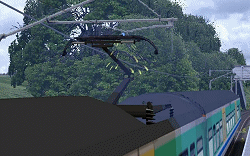 The latest additions to Cross-City South v1.4’s collection of animated objects include sparking effects between the pantograph head and the contact wire. These spark objects aren’t just small points of blue with emissive properties, but they flicker and flash, and through the use of a large surface with a mainly translucent blue sunburst gradient texture with emissive properties applied to it’s mesh, appear to illuminate anything behind the surface, creating quite a nice effect, especially in low light or at night. Through the use of texture shifting, yellow sparks also appear to fly off the pantograph head.
The latest additions to Cross-City South v1.4’s collection of animated objects include sparking effects between the pantograph head and the contact wire. These spark objects aren’t just small points of blue with emissive properties, but they flicker and flash, and through the use of a large surface with a mainly translucent blue sunburst gradient texture with emissive properties applied to it’s mesh, appear to illuminate anything behind the surface, creating quite a nice effect, especially in low light or at night. Through the use of texture shifting, yellow sparks also appear to fly off the pantograph head.
I originally wondered if this effect should be included in an animated car object along with the animated doors, wheels and so-on which are already planned, where the meshes with spark textures are positioned at the centre of the pantograph head, and perhaps flash depending on the speed of the train. However, my routes feature overhead lines which are registered and staggered (i.e. they zig-zag from left to right where appropriate), which could render the sparking effect less effective if the spark itself doesn’t appear near enough to where the contact wire is touching the pantograph head at a particular location in the route. Including the spark objects in the route itself rather than the car object allows me to overcome this little problem and align the spark with the contact wire, even if it takes longer to add the objects to the route. The animations are controlled using the Distance[i] variable, but with a very low distance specified, so the sparking is only visible for a short time as the centre of the referenced car is within around a metre of the animated object’s insertion point. The spark csv objects themselves are offset along the z-axis, so as the referenced car’s centre passes the animated object’s insertion location, the spark is displayed where the pantograph is located instead. As with the animated vegetation, I’ll include this effect at station areas, and points of interest.
A new video is available below to demonstrate the effect; I’ve included it as part of a compilation of my previous videos and uploaded the full video to YouTube this time. It’s available in YouTube’s High Definition format (embedded below), and a link to the high quality version on YouTube can also be found below, if you don’t have the downstream bandwidth or a fast enough CPU/graphics card to watch the higher resolution content smoothly.
|
Video: Demonstration of animated object based sparking effects, along with a compilation of previous openBVE videos:
|
Tags: Animated Objects, Cross-City South, openBVE, Videos, Watford Jn to Rugby
Posted in openBVE | 10 Comments »
Fewer updates and unseen work…
Posted by Anthony Bowden on 25th January 2009 at 9:00 pmThere aren’t as many progress updates at the moment, partly due to hardware upgrades and operating system re-installations, etc, but that doesn’t mean I haven’t been busy; rather there’s just been quite a bit of work which is either “under the hood”, or merely a continuation of features I’ve already talked about. For example, I’m still implementing transition curves throughout the Cross-City South, however I’ve also updated most of the curve radii after determining the likely values from aerial photographs of the route (thanks to » this thread « at the Trainsimcentral forum). Quite a number of curve radii were too large previously, and the route is looking more accurate now as a result of the changes, but it’s taking time, as changing the curve radii also means the overhead wire object rotations are no longer correct and don’t join up with each other any more, and all these objects need to be re-aligned, which is rather tedious and time consuming.
I’ve also been editing the route file as I proceed through it, re-arranging the code and commands to make the file easier to read and navigate through; not just to make the work tidier and weed out bad code, but also for the benefit of anyone wanting to more easily edit the route after it’s released, create new diagrams/scenarios/activities if so desired, etc. Previously I simply placed all commands at a particular line number on the same line; this meant that scrolling vertically through the route file in a text editor is easier and quicker for me (which I spend more time doing as a rule), however when numerous commands are placed on the same line, despite me usually making some effort to group and order them, this can make it harder to find a command and edit it, and also I gather, makes it harder for others to feel comfortable editing it too, as it seems too complicated. This time, I’ve compromised and placed groups of related commands on their own lines, so for example, catenary related commands are placed together on their own line; scenery, curve and railtype, or pointwork related commands are all placed on their own seperate lines, etc, making it easier to locate a command, without the route file becoming excessively long.
I’ve also now re-introduced the marker images which used to feature in the BVE 2 versions of the route, and it’s nice to have them back again in » openBVE «. One of the main tasks in the immediate future will be taking the animated features I’ve demonstrated so far, and extending them throughout the length of the route, rather than just the test locations which are featured in the videos, along with creating more detailed geometry for the 323’s exterior car objects, and preparing animated components like wheels, wipers, doors, and perhaps other things too.
Tags: Animated Objects, Cross-City South, openBVE, Trackwork
Posted in openBVE | No Comments »
